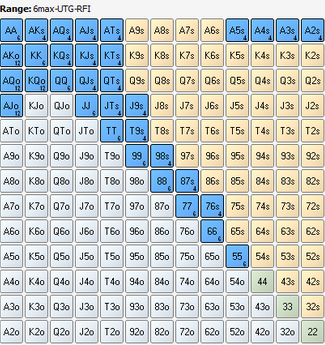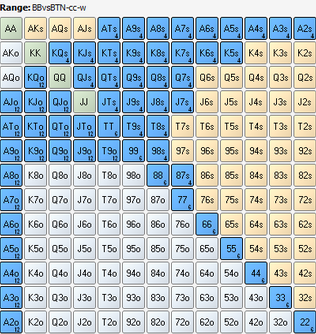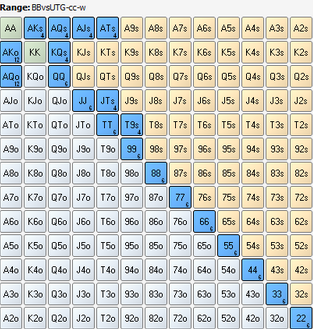Under-the-gun or UTG poker strategy is essential to understand if you want to be successful at playing positional poker.
 The truth is that most of our money will not be made from playing in early position. Nevertheless these positions are important and do contribute to our overall profits. We want to avoid making mistakes from this position which eat into our overall winrate.
The truth is that most of our money will not be made from playing in early position. Nevertheless these positions are important and do contribute to our overall profits. We want to avoid making mistakes from this position which eat into our overall winrate.
Under the gun is a poker term which essentially means
“first to act”. So it will be a different position at the table depending on whether it’s a short-handed or full-ring game.
Since there are so many players left to act after us, especially in the case of a full-ring game,
it makes sense to play very tight poker. Let’s have a look at some basic raise-first-in ranges for both a 6max cash game and a 9max cash game.
6-Max UTG
We can see
that this is a pretty tightrange, and UTG on a FR table will be even more so.
The most common mistake players make when opening from UTG
is to open hands like ATo and KJo. While these offsuit
broadway type hands play very well in a late position battle
they are often going to run into trouble when opening from an early position.
The reason for this is down to domination. In a late position battle our opponents can show up with all kinds of worse Kx and Ax hands. When we open from UTG and someone calls
we will often find ourselves playing against better Ax hands such as AJ,AQ or AK. Hopefully you can see why this is potentially problematic. If the flop comes Axx. It will be very difficult for us to get away from our hand assuming we flop top-pair with something like ATo.
FR – UTG
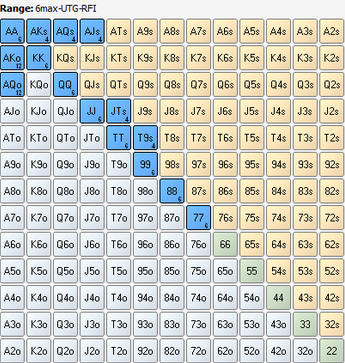
Assuming we play FR we need to tighten our ranges up even further as we can see above.
Players make similar mistakes in FR and will try to open hands such as KQo and AJo. These hands will get us into a lot of trouble since they are often dominated.
Notice also that we prefer opening a hand like 9Ts to QJs. 9Ts is way less dominated than QJs (our opponents are playing less hands with a Nine or a Ten in them), and 9Ts can make a larger number of straights and hence has better playability than the QJs.Understanding Postflop Ranges

It’s important to understand that when our open-raise gets called, the situation is going to be somewhat different compared to when our late position open gets called. We might have exactly the same hand on the same board
texture, but the best way to play the hand can be different. Why is this the case?
It essentially comes down to our opponent’s preflop range. When we open-raise from UTG our opponents perceive us to be stronger compared to when we open-raise in late position. As a result it’s common for our opponents
to cold-call tighter when facing an early-position open. The effect of this can be quite dramatic.
Check out the ranges below. The first range is what someone might typically cold-call BB versus a BTN open, while the second is what someone may typically cold-call BB versus a UTG open.
Hopefully we can see that difference is huge. That’s a 9% cold-calling range compared to a 31% cold-calling range. We should be able to see that it will be a little tougher to
extract thin value from our opponent after they call against our early-position open. A decent chunk of their defending range is actually going to be pocket-pairs looking to set-mine, whereas versus a late position open they have a much larger amount of speculative holdings.
Defending vs 3bets
A common problem when opening UTG is facing a 3bet. It’s important to keep in mind that since our opponents already perceive us as strong, it’s unlikely they are 3betting us with an especially wide range. As a result our continuing range is nearly always going to be very strong.
A mistake here will usually be calling with dominated broadways such as AJo and speculative hands such as Axs or suited-connectors. While suited-connectors might seem a reasonable choice at first glance since they can flop big, the truth is that
they don’t flop well often enough for us to make back all the money we lose when we miss.There are exceptions however. Assuming the stacks get considerably deeper than 100bb then we may be able to make enough money when we hit to make speculative hands a viable defend.
Let’s imagine we open from UTG on a 6-handed table with 100bb effective stacks. What should our calling range versus a 3bet look like?
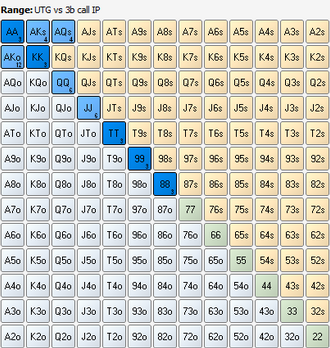
As we can see this is an extremely tight range (3.54%). You might be wondering why some of the hands are marked in a darker shade of blue. The reason for the AA/KK hands is quite simple.
We will likely be 4betting these hands a decent chunk of the time when facing a 3bet. However, it’s also acceptable to
slowplay them some percentage of the time preflop.
The pocket pairs are marked in dark blue for a different reason. Find out why below.
Can we Setmine vs a 3bet?

If we had a dollar for every time someone asked us this question well... we would have a lot of dollars! There seems to be advocates on both sides of the fence, some saying it’s completely incorrect, others insisting that it is standard.
The actual answer to this question is as follows. It depends. Like many situations in poker it is not possible to give a categorical answer. So what does it depend on? In short, our implied odds. Implied odds is essentially a fancy way of saying “how much will we make when we hit?”.

Seeing as
we miss our set around 87.5% of the time, we need to be somewhat assured that will have a sufficiently big payout if we do hit. So essentially where the 88-TT are marked in dark blue it means
“Call if we have good implieds, but fold if we don’t”.
So how do we know if we have good implieds? We won’t get into a big discussion on implied odds right now, but you can check out
Bitesize Poker Concept - Implied Odds a brief video on the concept. There are two main things we are looking for though.
- 1 – Opponent has a strong range (often the case when 3betting vs UTG).
- 2 – Opponent has deeper stacks than 100bb.
If either of these things are true then we can usually look to set-mine at least 88+. Remember that the stacks need to be at least 100bb or we will not have the right implied odds.
Keep in mind that if the stacks are close to 100bb we will not typically make a lot of money with our set-mines. Close to nothing in fact. However it won’t necessarily be a losing play and there are some other additional advantages, such as we won’t be folding to every 3bet and our opponents will not be so inclined to 3bet bluff us.
FR UTG vs 3bet
So let’s take a quick look at how we adjust our strategy when opening from UTG on a 9-handed table and facing a 3bet.
At first glance there may not appear to be a big difference. The differences are mainly subtle.
Firstly we can see AQs is gone, it’s not really strong enough to call with in most FR games. JJ and AK have turned to dark blue. This means that JJ is no longer a call for value but has been demoted to set-mine. We need the right implied odds or we fold. With AKo we can now seriously consider folding to a 3bet, it really depends how tight our opponents are. We will often find that at lower limit FR guys, many players are purely 3betting KK/AA, sometimes even just AA, vs a UTG open, meaning AKo can be potentially be garbage.
Note that KK has now changed to light blue meaning that it is nearly always a call. So if we open from UTG with KK and a player in the SB decides to 3bet us we should just call rather than 4betting.
If we 4bet we will very often only get action from AA. You will hear it said a lot that KK is always a stack off preflop no-matter the situation and that it’s a cooler if we run into AA. In this particular case, it isn’t.
We can actually see then that our only 4-bet for value hand is AA when opening UTG in FR. This is potentially unbalanced, but doesn’t matter in the slightest in lower limit games. Keep in mind that if this ever becomes a problem we can just choose to have zero 4-betting range and flat AA when we face a 3bet!
Putting it Together
Remember that unlike the blinds, our winrate from UTG should be positive. Just because we have to play tight in this position doesn’t mean we can’t make money.
If you follow the advice in this article and avoid getting out of line with marginal or speculative hands then
there is no reason why your UTG play can’t give a nice boost to your overall winrate.Other Top Recommended Content By Adam Jones
If you enjoyed reading this article, check out other top recommended articles by Adam Jones!
Or why not take a look at some of Adams PokerVIP coaching videos?


